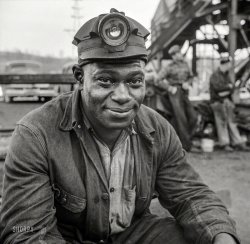
MAY CONTAIN NUTS

Search Shorpy
SHORPY ART

Framed or unframed, desk size to sofa size, printed by us in Arizona and Alabama since 2007. Explore now.
Join and Share
Ad-Free Shorpy
Shorpy is funded by you. Patreon contributors get an ad-free experience.
Learn more.

Recent comments
- Hudson’s Big Store
- Say what??
- Grapes?!
- A Beautiful Moment
- Such joy
- Bethune-Cookman University today...
- Yellow sky at morning
- Side Winder
- Air Quality?
- Sojourner Truth riot
- None were so blind(ed)
- The less famous sister
- Good ol' days?
- Rise and Fall
- Goo Goo Ga Joob
- Ticket Retention
- Not the only one
- Vagaries of War
- Killed by Amtrak
- Back to the Future
- Wanted --
- If you can't stand the light
- Centralized Traffic Control, I believe
- What's really happening
- Heckuva remote control!
- Sometimes — Things Go Bump!
- I SEE THE LIGHT
- Union Switch and Signal Company
- Get That Light Out Of My Eyes
- Eggs. Eggs. Eggs. The Egg Man is Here!
Member Photos
The Shorpy
Print Emporium
Print Emporium
Search Shorpy
Search results -- 30 results per page
- Diamond Alkali: 1950ish
- ... a living."
Trade Show Booth Looks like to me.
Pittsburgh and Everywhere!
Oh we are having fun Probably not as popular ... Virginia by a group of glass industry businessmen from Pittsburgh. The company soon established a large chemical plant at Painesville, ... Posted by John.Debold - 09/20/2011 - 9:10pm -
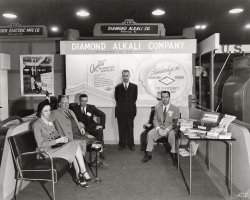
- The Rubber Store: 1908
- Pittsburgh, Pennsylvania, circa 1908. "Liberty Avenue at Seventh Avenue, ... was named for Thomas J. Keenan, principal owner of the Pittsburgh Press. Keenan kept the dome as his luxurious penthouse. Rumors that he entertained a whole generation of Pittsburgh women there gave the building a scandalous reputation.
The dome ... Posted by Dave - 09/02/2021 - 1:53pm -
![The Rubber Store: 1908 Pittsburgh, Pennsylvania, circa 1908. "Liberty Avenue at Seventh Avenue, looking west." 8x10 inch dry plate glass negative, Detroit Publishing Company. View full size.
The Rubber StoreI mean, I chuckled for a sec but rememembering this was 1908, assume it meant galoshes, boots and maybe hipwaders for the sporting types. Not, um ... you know.
[Also hot water bottles, trusses, irrigation bulbs, rubber gloves, etc. - Dave]
+103Below is the same view from July of 2011.
About that domed building...I used to work one block south of this scene. From my office on the 23rd floor, I looked out at the Keenan Building. When completed in 1907, the building was the tallest in the city. Its dome was originally gilded, but is now dark red.
The building was named for Thomas J. Keenan, principal owner of the Pittsburgh Press. Keenan kept the dome as his luxurious penthouse. Rumors that he entertained a whole generation of Pittsburgh women there gave the building a scandalous reputation.
The dome has been used for storage for many years.
Help Me OutI keep falling into the images produced by 8x10 Glass Negatives.
On another topic, recalling a Monty Python scene in the short attached to 'The Meaning Of Life' - a Very Big Corporation executive asks the Board "Did someone say people aren't wearing enough hats?"
(The Gallery, DPC, Pittsburgh, Stores & Markets, Streetcars)](https://www.shorpy.com/files/images/SHORPY-4a18554a1.thumbnail.jpg)
- Hotel Henry: 1908
- Circa 1908. "Fifth Avenue, Pittsburgh, Pennsylvania." Plenty of free parking for the automobilists among ... mere hotel "Upon a commanding site in the very heart of Pittsburgh, that glowing metropolis of untiring industry, stands a pre-eminent ... a quick bio - born Elk County, PA 1865, 1890 appointed Pittsburgh patrolman, 1893 made lieutenant of police in First district, for ... Posted by Dave - 07/30/2012 - 4:37pm -
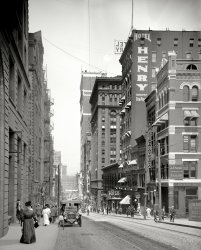
- Over and Up: 1908
- Continuing our tour of Pittsburgh circa 1908. "Pittsburgh & Lake Erie R.R. station and Mount Washington -- Smithfield ... any old limousine.
(The Gallery, Boats & Bridges, DPC, Pittsburgh, Railroads) ... Posted by Dave - 08/02/2012 - 9:53pm -
![Over and Up: 1908 Continuing our tour of Pittsburgh circa 1908. "Pittsburgh & Lake Erie R.R. station and Mount Washington -- Smithfield Street Bridge and Monongahela Incline." 8x10 inch glass negative, Detroit Publishing Company. View full size.
A penny for your thoughtsWell, a penny for your weight anyway. Check out that penny scale up on the near side of the bridge. Those things are worth a "pretty penny" today as collector items. What a neato bridge, they just don't make them like that anymore.
Still looks the sameThe bridge itself was only guaranteed to last for 15 years when it was first built.
Motor or Naptha Launch?The small boat tied up in left foreground is interesting because it lacks a prominent funnel. In this period, most powered craft were steam driven and would have had a large, tall funnel. This could be a naptha launch, which might not require such a large exhaust, or it could be powered by an early gasoline or diesel engine.
Looking at it carefully it could be a passenger ferry? The long superstructure made me thinik it might be a yacht but being able to see through the windows on both sides throughout its length suggests a simpler interior with rows of seats, not luxury accommodations with sleeping quarters.
Just add roller coaster carsand a ramp! (Don't for get your life jacket. You know, just in case.)
Motor? Launch"LUZON", perhaps?
[Correct.]
Signs of the timesThe signs advertising the Quaker Toasted Corn Flakes and the Gazette-Times must have been something to see. They look (by my estimate) to be about 15 feet or so high and a good one hundred feet or so in length.
InclineFrom what I see in the recent picture, and the online street view map, I'm curious... is the incline still there and in use?
[Yes.]
Looks like a commuterThe Luzon looks like a commuter or sight seeing launch - some of the old New York Harbor commuters built by the wealthy mucky mucks were absolutely stunning, definitely a step up from any old limousine.
(The Gallery, Boats & Bridges, DPC, Pittsburgh, Railroads)](https://www.shorpy.com/files/images/SHORPY_4a22936a.thumbnail.jpg)
- Point Bridge: 1900
- Pittsburgh circa 1900. "Point Bridge and coal barges." Note the Duquesne ... & Ruben, Reliable Clothiers" could have been to Pittsburgh what the "HOLLYWOOD" sign was to Los Angeles. Talk about placement. ... from July of 2011.
(The Gallery, Boats & Bridges, DPC, Pittsburgh, Railroads) ... Posted by Dave - 08/03/2012 - 1:37pm -
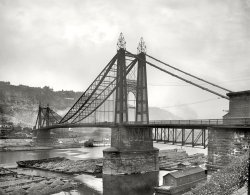
- Forbes Avenue: 1909
- Circa 1909. "Residences, Forbes Avenue -- Pittsburgh, Pennsylvania." Next stop, Swissvale. 8x10 inch dry plate glass ... Co The sign in the distance says "Vacuum Cleaner Co Pittsburgh". According to the 1908 Pittsburgh Business directory, there was a ... Posted by Dave - 10/04/2020 - 8:08pm -
![Forbes Avenue: 1909 Circa 1909. "Residences, Forbes Avenue -- Pittsburgh, Pennsylvania." Next stop, Swissvale. 8x10 inch dry plate glass negative, Detroit Publishing Company. View full size.
My hat's off to the gardenerAfter noting the three flights of stairs leading to the mansion on the left, I tried to imagine myself being tasked with mowing that lawn using a hand lawnmower. As a youngster in the late 1940s I mowed my family's flat lawn using a hand mower until I was about 15 years old so I am quite familiar with the state-of-the art in lawn maintenance, as it must have been in 1909.
When I was about 15 my dad loaned me money to purchase a power mower that I used to earn money mowing other lawns in our neighborhood, which was used to repay him. That's how we learned business sense in those days.
[1-hp mowers were not uncommon in 1909. - Dave]
Vacuum Cleaner CoThe sign in the distance says "Vacuum Cleaner Co Pittsburgh". According to the 1908 Pittsburgh Business directory, there was a cleaning service called "Vacuum Cleaner Co" at 4614 Forbes. If that clue is accurate, the houses on the left are now Carnegie Mellon and this is the view:
Gardener's Problem -- Solved!This appears to be the same building, now part of Temple Sinai at 5505 Forbes Ave.
If it is the same building, the street has been raised considerably.
UPDATE: No, it's not the same building.
A Lawn Way DownThat sloping lawn is pure decoration -- nobody could lie on it. Imagine being 6 and rolling down the slope to land Plop on the sidewalk! OW!
Toastrack StreetcarsThe two streetcars in this view appear to be open air summer trolleys, with cross bench seating and a running board for the conductor. These were popular for summer excursions and city tours, and these Pittsburgh cars may have been on a tour of the Forbes Street neighbourhood, which still looks upscale today. An example of such a car can be seen below.
(The Gallery, DPC, Pittsburgh, Streetcars)](https://www.shorpy.com/files/images/SHORPY-4a23346a.thumbnail.jpg)
- Men's Doctor: 1938
- May 1938. "Quack doctor -- Pittsburgh, Pennsylvania." 35mm nitrate negative by Arthur Rothstein for the ... comes for free.
(The Gallery, Arthur Rothstein, Pittsburgh) ... Posted by Dave - 04/15/2012 - 3:14am -
![Men's Doctor: 1938 May 1938. "Quack doctor -- Pittsburgh, Pennsylvania." 35mm nitrate negative by Arthur Rothstein for the Farm Security Administration. View full size.
ProgressNow the August Wilson Center for African American Culture.
How much you wanna betHis free advice was "Always pay the doctor"!
Grammar?Surely the apostrophe should follow the S, as in MENS' DOCTOR.
[Incorrect. The plural of "man" is "men," not "mens." The singular and plural possessives are man's doctor, men's doctor. Child's doctor, children's doctor. Woman's clothing, women's clothing. - Dave]
Zimmerman BuildingAt 10th and Liberty, demolished 2005.
Other Views of the Zimmerman BuildingBelow are a few more view of the old Zimmerman Building
Signs aboundAn interesting collection.
Demolition in progressZimmerman building about 90% demolished, October 2005 --
Quack.At first glance, I wondered why the title of the image alluded to the physician as being a fraudulent practitioner of medicine. Upon closer examination, I noticed "Free Advise" above the main sign! Also, the mention of being an interpreter of foreign languages as a sideline seems to confirm the "quack" diagnosis!
Downtown Doctor Slain, 633 LibertyAccording to The Pittsburg Press of Sept. 15, 1939, our dear Dr. Quack, a.k.a. Dr. Frank G. Leslie, got his due. It's the sad tale of one Mike Koski, who was apparently not cured of venereal disease as promised. He therefore walked into the office and shot Dr. Leslie to death. Wow. The details read like a crime tabloid complete with lurid pictures on Page 2. The details allude to a possible doctor behind the doctor, one Dr. Joseph Cerra (our language interpreter), who hired Leslie to front the operation. My free advice is nothing comes for free.
(The Gallery, Arthur Rothstein, Pittsburgh)](https://www.shorpy.com/files/images/SHORPY_8a09811a.thumbnail.jpg)
- Outfall: 1936
- September 1936. "Pittsburgh waterfront, Monongahela and Allegheny Rivers." Medium format nitrate ... in the water My dad grew up in Braddock (a part of Pittsburgh) quite near and perhaps even more polluted than this photo shows. ... population.
(The Gallery, Arthur Rothstein, Factories, Pittsburgh) ... Posted by Dave - 04/24/2011 - 10:47pm -
![Outfall: 1936 September 1936. "Pittsburgh waterfront, Monongahela and Allegheny Rivers." Medium format nitrate negative by Arthur Rothstein for the FSA. View full size.
Down by the Win-e-gar WoiksOh I live under the viaduct
Down by the winegar woiks
Where they chain all the chilluns
To fences and logs
They do it to keep 'em
From biting the dogs
Oh I live under the viaduct
Down by the winegar woiks!
AnglingThis is where I caught all those three-eyed fish.
How to seeThis is the kind of photo that black and white was made for.
ChromaIf this were colorized, it wouldn't change a bit except for the sky (yellow) and water (heaven knows what).
Employment versus pollution. The nasty, polluting steelmills are in China now.
We now have time without end to enjoy the fresh clean water and air. We have nothing to do, because the well paying jobs left too.
[In the 2008 national rankings, the United States was the world's third-largest producer of steel. - Dave]
Something in the waterMy dad grew up in Braddock (a part of Pittsburgh) quite near and perhaps even more polluted than this photo shows. All four of his daughters had to face breast cancer as adults (the first in either side of the family). Who knows if this may have been a contributing factor.
Mini-millsThe US, as the third-largest steel producer, puts out about 1/4 as much steel as the largest (China). US production is majority mini-mills these days. Still a lot of integrated steelmaking, but we've got a lot of scrap to use, and it costs less.
Incidentally, Japan is number two in steel production. They have 40% of our population.
(The Gallery, Arthur Rothstein, Factories, Pittsburgh)](https://www.shorpy.com/files/images/8b28269u.thumbnail.jpg)
- Appleton Here We Come: 1962
- ... no plane changes. It did, however, stop at Philadelphia, Pittsburgh, Cleveland, Detroit and Lansing along the way.
Please tell me ... Posted by Dave - 01/14/2013 - 5:10pm -
![Appleton Here We Come: 1962 October 1962. "Wisconsin plane trip." En route to Appleton, it's Mad Men with choreography. This would seem to have been a business trip made by Kermy and Janet's father from Baltimore. 35mm Kodachrome slide. View full size.
A long-vanished airlineNorth Central Airlines is now three generations into the past. It became Republic Airlines after a merger with Southern Airways in 1979, Northwest Airlines acquired Republic in 1986, and Northwest became part of Delta Air Lines in 2008. It's possible that there may be a few pre-1979 North Central employees still working for Delta, most likely flight attendants as they often stick around for decades.
The aircraft appears to be a Convair 340, one of the last of the pre-jet airliners.
Douglas DC-3First operationally flown in 1935, the Douglas DC-3 became a real workhorse of commercial airlines and of the U.S. Air Force as as the C-47. Some are still being flown today, mainly by smaller third world airlines. A few of the earliest DC-3s are still flying about 75 years after they were manufactured.
North Central Airlines was founded as Wisconsin Central Airlines in 1944. The name was changed to North Central in 1952 and headquarters moved to Minneapolis. North Central flew as many as 32 DC-3s during its existence. The airline ceased operations in 1979.
DC-3 StairsMy dad loved DC-3s and had one-- it might have been the C-47 version-- in the late 1960s. One day he tripped or caught his foot or something while coming down those little steps and broke his arm when he hit the tarmac.
The doctor asked him how he had injured himself, and my dad, a man of few words even when he wasn't in pain, replied he had fallen out of an airplane.
The doctor said, "Well, I don't know how high the plane was, but you got off pretty easy!"
DC-3/C-47The DC-3/C-47 is my favorite airplane; I built countless model variants as a kid. The North Central livery is particularly nice. More detail here.
MemoriesI can remember DC-3s flying over our small-town house to the local airport when I was a kid in the early 1960s. They seemed really huge to me at the time.
Whiskey CentralI well recall my father's jokes and asides regarding North Central Airlines -- or Whiskey Central, as he and not a few others preferred to call it in the early days. We lived in Eau Claire, Wis., home of Presto Industries and 25 below zero temperatures. As a traveling salesman for Presto, dad would occasionally ride Whiskey Central to some distant city on business. Be it the dead of winter, he never failed to carry a hip flask filled with Early Times, which he affectionately referred to as "my infallible portable heater."
He further noted, as I recall, that the stewardesses were all males, and very likely descended from hardy Viking stock accustomed to Icelandic weather. Atop their uniforms they wore fur-lined coats adorned with turned-up mink collars.
I also vividly remember standing beside my mother on the tarmac and waving back at my father as he paused halfway up the airplane ramp. And then remaining rooted to the spot until the speck in the sky disappeared from sight.
Jim PageGreat story; your dad sounds like my dad. Few words were too many.
N25651Click to enlarge. Photos by Kermy's dad of the plane in the main photo above.
AmazingThe old Gooney Bird is still in use to this day. What a great aircraft!
[The only thing still in use is the number N25651. It's assigned to a 21-year-old hot-air balloon. Our DC-3 was deregistered in 1990. - Dave]
Oh, I really thought there were some still in use.... you mean none flying
worldwide?
It'll get you there -- eventuallyI flew North Central in the summers in the early 70s. Convair 340s from Washington National (home) to my aunt and uncle's in Grand Rapids. As I was only about 10 at the time and traveling alone, my parents booked me on North Central as there were no plane changes. It did, however, stop at Philadelphia, Pittsburgh, Cleveland, Detroit and Lansing along the way.
Please tell methis plane had a lavatory.
A very old DC-3In fact not a DC-3 as such but a DST (Douglas Sleeper Transport) the original version built long before WW II with 16 sleeping berths for night flights, convertible to 24 seats for day use. It had Wright Cyclone engines not the more familiar Pratts.
N25651 had a long career. It was impressed into the army as a C-49 and postwar served not just North Central but also Galaxy, Holiday Hunters, Shorter and finally Bahamasair. It was last reported derelict at St Thomas in the US Virgin Islands.
PBA/Naples AirlinesIce Gang's comment is cool; living in Naples back in the 60s and being at the airport with my pilot dad all the time, I'd see those PBA/Naples Airlines planes a lot. At some point prior to those days, Provincetown/Boston Airlines had absorbed the old Naples Airlines, unless I remember it wrong-- which isn't impossible!
I remember hearing that old Naples Airport was the site of the first U.S. airplane hijacking; a fellow hijacked a plane there to fly him to Cuba. Now, I'll leave it up the the brilliant folks here on Shorpy.com to let me know if that little tidbit is correct or not.
I think it's really a DC-3I'm pretty sure it's not a DST. The DST's boarding door was on the right. It had auxiliary windows above the regular ones so the upper berth didn't feel too closed in, and Dave's picture of the full exterior doesn't show those.
Route of the Blue Goose"Route of the blue goose" was the tag, like "Wings of man" for Eastern, in the ads.
All dressed up-And somewhere to go. I wonder at what point travelers began dressing down for flights; it used to be an occasion and people dressed accordingly. I remember flying on the west coast's PSA in those days and always wearing a suit and tie, even as a teenager. We flew to from home in San Diego to Hollywood-Burbank and back for under $20 and still had money left for shopping trips to Desmond's and Silverwood's, nice Los angeles area clothing stores.
DC-3 hoursMany years back I flew from Tampa to Naples Florida on PBA airline, I was the only passenger and the pilot told me this DC-3 had the most hours of any DC-3, 84,876 hours, the plane is being restored in Washington and is still flying with over 91,400 hours (10 1/2 years in the air) Canadian Pacific Airlines had a flying Canada goose as it's logo, only it was flying to the right.
Dressing upI can only guess that the "dress code" for flying went away in the mid to late 60's (at least on the west coast). My first plane trip was in 1970, from Sacramento to L.A. on PSA, and I don't recall donning anything more than what I'd have worn on any given day (I was 17, so somewhat attuned to these things). But maybe I was just a slob.
Eight Years LaterI have a North Central flight schedule dated January 1, 1970, with 22 tiny print pages of flights. They really covered the Upper Midwest.
About that Dress CodeI don't think that they're dressed up just because they are flying. It appears to be a business trip, so the gentlemen are dressed just as they would if they were going to the office. This is still common practice for some companies today - if you're traveling for the company, you follow the dress code that's in place. But general office dress codes are less strict in many businesses now.
I flew in and out of Appleton on DC-3sYup---I flew from Appleton on a DC-3 to Chicago via Milwaukee when I went into the Navy in 1960. I would come home on leave to Appleton by air and through Chicago via Milwaukee--I'd arrive in a DC-3. Sometimes as few as two passengers would be on board from Milwaukee to Appleton. It was a bouncy ride from Chicago. History will show the DC-3s on North Central Air were tough birds--one collided with a small private plane between Chicago and Milwaukee---and carried the other craft all the way to safe landing in Milwaukee---the small plane imbedded in the DC-3s port bow. I am not sure the DC-3 views shown on Shorpy's are at the present airport location west of town or the one I remember on the north east side off Ballard road.
Dressed to FlyWe flew often during the 60s and 70s and I remember my mom making sure we all wore Sunday best - all five of us kids. In fact when packing our bags, the question was always posed to us - "What are you wearing on the plane?" It wasn't until the 80s that it was about dressing for comfort and then of course it morphed into dressing for airport security checks.
The connection between dress and self-respect as well as respect for the occasion has deteriorated quickly since the baby-boomer generation. Soon we'll all be wearing shorts and flip-flops to the office just like many do at church these days.
1975 versionHere's a picture of the DC-3 from 1975:
http://www.airlinefan.com/airline-photos/6642431/Shorter-Airlines/Dougla...
Never heard of "Shorter Airlines" but the picture says it was taken in Miami.
http://www.michaelprophet.com/imagesSanJuan1985_1989/55.jpg
This might be the same plane, it matches the paint scheme from the 1975 picture, but the registration number is covered by the bushes.
Sad it see it in that shape.
(Aviation, Kermy Kodachromes)](https://www.shorpy.com/files/images/SHORPY_Kermy086.thumbnail.jpg)
- Life in Wartime: 1942
- Pittsburgh, August 1942. "The comforts of home looked pretty good to Navy ... on Shorpy. - Dave]
(The Gallery, Alfred Palmer, Pittsburgh, WW2) ... Posted by Dave - 09/11/2011 - 11:34am -
![Life in Wartime: 1942 Pittsburgh, August 1942. "The comforts of home looked pretty good to Navy Radioman John Marshall Evans and Sergeant French L. Vineyard, who spent Sunday with the family of their poster colleague George Woolslayer." Medium format negative negative by Alfred Palmer for the OWI. View full size.
French Vineyard?I never thought I'd see a name to top Olive Groves (heard below), but that might just be it.
My GrandparentsGoogled my last name and was absolutely delighted to see my father's parents. I never knew this photo existed. For reference sake their names were Ethel Householder Woolslayer and George Anthony Woolslayer Sr.
[There are 48 more Woolslayer photos in the Library of Congress archive. And a couple more here on Shorpy. - Dave]
(The Gallery, Alfred Palmer, Pittsburgh, WW2)](https://www.shorpy.com/files/images/8e11122u_1.thumbnail.jpg)
- Billy Sunday Tabernacle: 1918
- ... spent 8 years as a big league outfielder with Chicago, Pittsburgh and Philadelphia in the National League? Could it have been his .248 ... Posted by Dave - 08/28/2012 - 6:38pm -
![Billy Sunday Tabernacle: 1918 January 1918. Washington, D.C. "Billy Sunday tabernacle." A temporary meeting hall built near Union Station for a three-month series of revival meetings held by the famous evangelist. Harris & Ewing Collection glass negative. View full size.
Streetcars!According to an article in The Post this week, streetcars are about to return to DC after a 50-year absence.
There it is!The honest to god, original Tourist Motel!
And to think, it all started because of Billy Sunday...
Well, probably not, but I love the hotel name.
Photographer's Vantage PointThe photographer's vantage point seems to be from an upper level window or the roof at the SE corner of the Union Station building. The view is looking south with First Street NE extending in the distance towards the Library of Congress dome.
What a weird structureAnd it looks like someone's been snowboarding off the roof.
Not seen in this photois a temporary wall of separation between church and state.
Switch TowerCan anybody identify the function of the elevated tower at the front left of the photo? I'm guessing that it might house the controls for the switches on the trolley car tracks. That might also explain the semaphore like device sticking out of the roof.
[That "semaphore" is a street sign on the lamppost near the horse. The switch tower is described in the comments under this photo. - Dave]
Popular EvangelistBilly Sunday, born in poverty and raised in an orphanage, was a magnetic personality who, after playing professional baseball in the 1880s, became one of the most popular Bible-thumping evangelists of his time. He was a large cog in the wheel that foisted Prohibition on America. Unlike many of his peers, before and since, Billy seems not to have had feet of clay.
Outfielder Billy SundayHow many knew that, in his 20s, the legendary Rev. Billy Sunday (1862-1935) spent 8 years as a big league outfielder with Chicago, Pittsburgh and Philadelphia in the National League? Could it have been his .248 career batting average that inspired him to give up his baseball career for a higher calling?
Out-of-townerAnybody know what that big dome-y structure up on the hill is? (You can have them ring me at my rooms in The Tourist.)
IncendiaryI'll bet the D.C. fire marshal held his breath for 3 months.
The Ghostly Horse And WagonThe horse and wagon to the extreme right look like true ghosts to me. They're very faint and I can see what looks like the entire curb behind them. They do cast shadows so I'm not calling on the supernatural to explain it yet. I've never seen such large moving objects look so ghostly with such sharp outlines. As an aside, there is an almost invisible bicyclist who is also casting a shadow midway between the trolleys.
Clean snow!By the number of wheel tracks in the snow, you can tell it's been on the ground awhile. With that in mind, it's nice to see WHITE snow. Those were the days of clean air.
[The air of 1918 was considerably dirtier than it is now. Coal soot. - Dave]
Who was the evangelist ?Billy Graham is the only one named Billy that I ever knew but he was born in 1918 so not likely to have preached the same year. Which "Billy" was speaking here ??
[Billy Sunday. Like it says in the title and the caption. - Dave]
Thanks Dave, I thought it meant that it was on a Sunday and since it is a tabernacle it is normal to think that. But thanks for answering.
[Aha! You're welcome. - Dave]
Urban and Spiritual RenewalDuring the early-century maneuvering over how to memorialize Lincoln, one of the sites considered was this general area, which was a slum between Capitol Hill and Union Station. The Lincoln Memorial was going to go up elsewhere, but it appears that a way was found to clear out the slums and simultaneously promote righteousness.
Eloquent, at times
Washington Post, May 25, 1889
Billy Sunday as a Revivalist
Billy Sunday, the clever right-fielder of the Pittsburg club, doffed his baseball uniform and made his first appearance in this city in the role of a revivalist, at the Central Union Mission last night. The hall was pretty well filled, and a great many came in while he was speaking. None of the members of either the Pittsburg or Washington clubs were present. After a service of song and a prayer by Mr. Sunday, he selected a text from the first chapter of John, fourth and fifth verses. The short sermon which followed was replete with interest, forcibly and, at times, eloquently given. He closed with a short prayer.
Washington Post, Nov 6, 1917
Ground is Broken for Tabernacle
Ground was broken in front of the Union Station plaza yesterday for the tabernacle which is to house the Billy Sunday revival here in January. The actual turning of the sod was performed by John C. Letts, chairman of the Sunday campaign committee. Post-master M.O. Chance presided.
The ceremony took place under one of the big Union Station flags at 12:15 o'clock p.m. in the presence of several hundred people who stood with bared heads until the exercises were completed.
The Rev. Charles Wood, pastor of the Church of the Covenant, and the Rev. James Gordon, of the First Congregational Church, delivered the prayers. Dr. James E. Walker, representing Billy Sunday, in his address said that Sunday comes to Washington to preach the simple word of God. "Not Mr. Sunday, but Washington is on trial," he concluded.
The permit to erect the tabernacle bears the signatures of Champ Clark, Vice President Marshall, and Supt. E.H. Woods, of the Capitol.
Another Billy Sunday referenceChicago, Chicago that toddling town
Chicago, Chicago I will show you around - I love it
Bet your bottom dollar you lose the blues in Chicago, Chicago
The town that Billy Sunday could not shut down
BrrrThe winter of 1917-18 was one of the coldest and snowiest of the 20th century. Many cold records were set that remain unbroken 90 years later.
http://www.semp.us/publications/biot_reader.php?BiotID=637
Room at the TouristWell, you can stay there, but I'm booking a room at the Hotel Wilmat, they have 'ROOMS'
(The Gallery, D.C., Harris + Ewing, Railroads, Streetcars)](https://www.shorpy.com/files/images/13802a.thumbnail.jpg)
- A Swell Soiree: 1942
- ... Vineyard is wearing the paper hat. Allegheny Steel, Pittsburgh." One in a series of dozens of photos taken of the three men in a ... it's ketchup, it's GOT to be Heinz. Especially if it's a Pittsburgh photograph! Great picture.
(The Gallery, Alfred Palmer, ... Posted by Dave - 09/11/2011 - 11:19am -
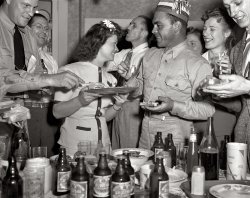
- Bankers Row: 1905
- Pittsburgh, Pennsylvania, circa 1905. "Pittsburgh Wall Street (4th Avenue)." 8x10 inch dry plate glass negative, ... is the same view from July of 2016.
(The Gallery, DPC, Pittsburgh) ... Posted by Dave - 08/01/2012 - 1:39pm -
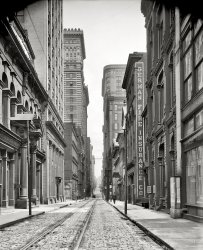
- Just a Dip At Twilight: 1938
- ... A homemade swimming pool for steelworkers' children in Pittsburgh, Pennsylvania. Photograph by Arthur Rothstein, July, 1938. View ... were already around even then.
(The Gallery, Kids, Pittsburgh) ... Posted by Ken - 09/07/2011 - 9:17pm -
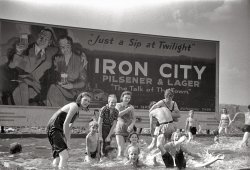
- Betty Crockers: 1935
- ...
Wringers During 1981-84 when I was in grad school in Pittsburgh new Bendix wringer washers could be bought in local appliance shops. Of course Pittsburgh used to be a place where steel was made.
B-CC: Bethesda Chevy ... Posted by Dave - 08/10/2012 - 12:32am -
![Betty Crockers: 1935 Bethesda, Maryland. "Cooking class, Chevy Chase High School, 1935." 5x7 safety negative, National Photo Company Collection. View full size.
The StoveCan you zoom in on the stove brand at all? I just find this photo fascinating.
[The one on the left is an "Insulated Glenwood" gas range. The wringer washer and mangle ironer are Apex brand. - Dave]
Serious BusinessThese are so no-nonsense cooks at work!
FHODFuture Homemakers of the Damned -- they are so not impressed with getting their picture taken.
ModernI've read comments before about how modern some people look in older pictures. I must say, almost all of these girls, given a change of clothes, I could see at the mall today.
Actually, what IS with their dresses? They're so similar but not exact...
Wish I'd been more domesticFor someone who spends all her time and money on things to make her home beautiful, I'm sure one terrible homemaker. My mother hated the PTA (cult for the passionless) and 1950s fashion (for the repressed). And loved people like Gloria Steinem. My sis and I could've learned a thing or two from this Home Ec crew. Love it. This whole site is a treasure.
http://hoveyvintage.blogspot.com
What's that machine?What's the woman on the right with her back towards us doing? Electric towel dryer? Dough Presser? And is the machine on the far right a clothes washer or dish washer? It WOULD take a woman from the 1930's to explain these things to me!
[Electric ironer and wringer washer. - Dave]
Wringer WasherI remember those when I was a little boy in the early 60's..... yes, they were still around then.
Through the WringerWe had one in the basement of the house my parents rented in about 1974. My sister and brothers told me it would suck my hand in and eat me if I got too close.
MangleIn England, the two wringers on a washing machine were called a mangle, but in America the two-roller ironing machine took the same name.
Ironrite ?It looks Like an Ironrite ironing machine to me.
[Apex. - Dave]
FuturamaIt will get better someday, ladies, I promise. There are microwaves on the horizon, steam irons, smooth cooktops, food processors, and top loading six-cycle washers to look forward to.
My mom thought it'd eat her too!My grandmother used a wringer washer till she died, which was just last year.
Yes, they still sell them; she had to buy a new one just a few years ago!
Wringer WasherJust who sells Wringer Washers today? I've never seen any at Sears or other appliance stores.
New WringerWringer Washer for sale.
Yours for only $899, plus shipping and freight. Made in Saudi Arabia.
WringersDuring 1981-84 when I was in grad school in Pittsburgh new Bendix wringer washers could be bought in local appliance shops. Of course Pittsburgh used to be a place where steel was made.
B-CC: Bethesda Chevy ChaseI went to B-CC High School..
they have upgraded the home ec facilities since then
www.gwadzilla.blogspot.com
(The Gallery, Education, Schools, Kitchens etc., Natl Photo)](https://www.shorpy.com/files/images/28278u.thumbnail.jpg)
- Shut This Door That Means You
- ... he worked the rest of his life as a glass cutter for the Pittsburgh Plate Glass Company in Clarksburg, West Virginia. In the 1920s, he ... Posted by Dave - 01/08/2009 - 11:24am -
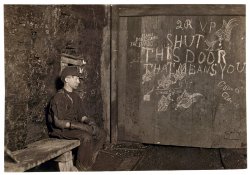
- Carson Street Depot: 1938
- July 1938. "Pittsburgh. View of the city from Homestead." Medium format acetate negative by ... bends in the Monongahela River to have a view of downtown Pittsburgh.
601 East Carson Street hasn't changed much in 80-plus years. ... in both pictures.
(The Gallery, Arthur Rothstein, Pittsburgh, Railroads) ... Posted by Dave - 05/01/2020 - 11:50am -
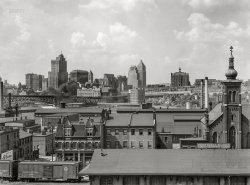
- Wood Street: 1908
- Circa 1908. "Wood Street, Pittsburgh, Pennsylvania." A good look at the street-rail infrastructure in ... sight.
Sunday morning? Where is everyone? Pittsburgh was a bustling city with a very active downtown in 1905. I'd expect ... What has happened to our world?
(The Gallery, DPC, Pittsburgh, Streetcars) ... Posted by Dave - 04/19/2016 - 6:15pm -
![Wood Street: 1908 Circa 1908. "Wood Street, Pittsburgh, Pennsylvania." A good look at the street-rail infrastructure in place 100 years ago. 8x10 inch glass negative. View full size.
BrutalizedI didn't realize that the building on the left foreground was the same with the 80s streetfriendly reduction.
Fancy Building & Peoples Bank remainHard to see People's Bank but I think it is there. The fancy building on the right is in plain sight.
Sunday morning? Where is everyone?Pittsburgh was a bustling city with a very active downtown in 1905. I'd expect to see a lot more traffic, both pedestrian and vehicular. So I'm guessing this was Sunday morning, when all proper people would be in church, but not so early that the woman crossing in front was afraid to go out.
Optical IllusionBefore I supersized this photo I thought that was snow on the street. Bad eyes or wishful thinking, I sure was hoping to cool off with a peek at snow. Bummer.
[Would you settle for an airborne bugle with a Seussian finial? - Dave]
Way cool Dave, thanks!
+106Below is the same view from July of 2011.
Lost soulIn virtually every original scene that has been presented on Shorpy, when someone has posted the same scene today, the spirit, the soul, the humanity, the beauty is gone. What has happened to our world?
(The Gallery, DPC, Pittsburgh, Streetcars)](https://www.shorpy.com/files/images/SHORPY-4a18551a.thumbnail.jpg)
- Cold-Rolled: 1941
- January 1941. "Mill district of Pittsburgh, Pennsylvania. Long stairway in a working class section." Acetate ...
It looks like a stairway, but it’s a street Pittsburgh has hundreds of stairways like these, many of them categorized as ... the city unique.
Ernie Pyle wrote of the steps of Pittsburgh: “Oh Lord, the steps! I was told they actually had a Department of ... Posted by Dave - 12/22/2018 - 11:14am -
![Cold-Rolled: 1941 January 1941. "Mill district of Pittsburgh, Pennsylvania. Long stairway in a working class section." Acetate negative by Jack Delano. View full size.
It looks like a stairway, but it’s a street Pittsburgh has hundreds of stairways like these, many of them categorized as city streets. They’re one of the things that make the city unique.
Ernie Pyle wrote of the steps of Pittsburgh: “Oh Lord, the steps! I was told they actually had a Department of Steps. That isn’t exactly true, although they do have an Inspector of Steps. But there are nearly 15 miles of city-owned steps, going up mountainsides.“
SlipperyLook at those women further down the hill, linking arms. With the slope and the packed snow, I can imagine the grip underfoot was precarious.
Jack DelanoI really appreciate all the Delano photos you have been posting. Many I have not seen before. We have all seen this one; if it's not his greatest photo it's his greatest landscape.
[This is a "new" photo that we have not seen before, although similar to the one posted earlier here. - Dave]
He loved shadows, dirty snow, night cityscapes, old buildings, locomotives and, mostly, workers and ordinary people in general. He goes past the pathos so abundant in those years and gets to the dignity of workers and poor people. My favorite is of a young black woman wearing her best suit and a tilted white hat while leaning on a rail and waiting for a bus to the next agricultural job. He was born in the Ukraine, grew up in N.Y.C. and spent the last half of his life in Porto Rico, which he loved. He would probably have considered himself a musician (composer) first and a photographer second. His autobiography "Photographic Memories" is worth finding.
Another Fine MessSomehow, I can't help but envision Laurel and Hardy trying to move a piano up this stairway.
Burgh StairsThis brings back memories of out-of-town drivers being confounded by streets suddenly turning to stairs, even though a through street showed on a map.
Taking a ChanceThis is intersection of the short Chance Way, ambling off to the left at the bottom of the wooden stairs and Tullymet Street diving steeply down to Irvine and the Coal/Coke plants, now gone. In a modern view the only feature left are some newer concrete stairs with metal railings and that house in the left foreground, still very recognizable.
(The Gallery, Factories, Jack Delano, Pittsburgh)](https://www.shorpy.com/files/images/SHORPY-8c04611a.thumbnail.jpg)
- Bus Baggage: 1943
- September 1943. "Pittsburgh, Pennsylvania. Bringing baggage from a bus." Photo by Esther Bubley ... hotel in the background is the old Fort Pitt Hotel in Pittsburgh, Pennsylvania.
[Thankyou! - Dave]
It's very film ...
(The Gallery, Cars, Trucks, Buses, Esther Bubley, Pittsburgh) ... Posted by Dave - 09/17/2014 - 3:06pm -
![Bus Baggage: 1943 September 1943. "Pittsburgh, Pennsylvania. Bringing baggage from a bus." Photo by Esther Bubley for the Office of War Information. View full size.
Not in ColumbusThe bus may be Columbus bound but that big hotel in the background is the old Fort Pitt Hotel in Pittsburgh, Pennsylvania.
[Thankyou! - Dave]
It's very film noirish...in a dark, sort of gloomy way. A bus station in a dark, gritty downtown terminal.
You can almost smell it.
Fort Hayes HotelLooking at the sign on the building behind, that may be the Fort Hayes Hotel which is long gone.
Deja vu...Recently, flying home non-stop from Boston to San Francisco...
It felt exactly like we remember being treated as a Bus Passenger in the 1960's!
Ah, Esther!She's always great.
(The Gallery, Cars, Trucks, Buses, Esther Bubley, Pittsburgh)](https://www.shorpy.com/files/images/SHORPY-8d33007a.thumbnail.jpg)
- Shop at Rosenbaums: 1941
- August 1941. "Pittsburgh along the Monongahela River." Medium format acetate negative by ... is an interesting little architectural oddity- the Wabash Pittsburgh Terminal Railway station. The long, barn-like trainshed covers the ... to give the forecast. This was the tallest building in Pittsburgh until 1970.
Interestingly, the Koppers Building has a copper ... Posted by Dave - 11/02/2019 - 5:34pm -
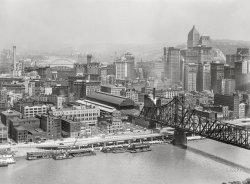
- Above the Nixon: 1914
- Pittsburgh, Pennsylvania, circa 1914. "Sixth Avenue above the Nixon Theatre." ... As someone who lives very close to and works in Pittsburgh, I can almost hear someone in this pic saying, "Yinz wanna head ...
(Technology, The Gallery, Cars, Trucks, Buses, DPC, Pittsburgh) ... Posted by Dave - 02/28/2014 - 8:25am -
![Above the Nixon: 1914 Pittsburgh, Pennsylvania, circa 1914. "Sixth Avenue above the Nixon Theatre." Home to the Nixon Cafe. Note the theater's "digital" carriage call. 8x10 inch dry plate glass negative, Detroit Publishing Company. View full size.
Employment DreamYou can see how effective the corner Employment Office was by seeing the guy with the broom in the street. And that ain't hay.
Much has changedBut the light building on the right is still there.
[Not to mention the one across the street. -tterrace]
View Larger Map
Carriage Call CodingFrom the picture via previous post, I'm puzzled by the coding of the ticket. Certainly not anything I've ever seen in punched cards, tickets, etc. Anyone?
"Yinzer" ancestorsAs someone who lives very close to and works in Pittsburgh, I can almost hear someone in this pic saying, "Yinz wanna head dahntahn in a buggy to get a chipped ham sammich 'n at?"
+102Below is the same view from July of 2016.
(Technology, The Gallery, Cars, Trucks, Buses, DPC, Pittsburgh)](https://www.shorpy.com/files/images/SHORPY_4a24746a.thumbnail.jpg)
- Magic Kingdom: 1905
- ... glad places like Cedar Point in Ohio, Kennywood Park in Pittsburgh and Lake Compounce in Connecticut are still around.
Another ... Posted by Dave - 08/15/2012 - 4:14pm -
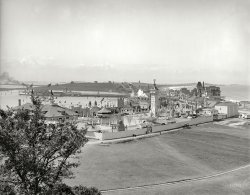
- Seven Bridges: 1912
- Pittsburgh circa 1912. "Coal barges at 'The Point' -- Confluence of Allegheny ... it was destroyed some time ago, if you Google photos of Pittsburgh in the 1950s, you will see it was still in use then.
Little ... this? -tterrace]
(The Gallery, Boats & Bridges, DPC, Pittsburgh) ... Posted by Dave - 08/28/2017 - 7:17pm -
![Seven Bridges: 1912 Pittsburgh circa 1912. "Coal barges at 'The Point' -- Confluence of Allegheny and Monongahela at start of Ohio River." A bounty of seven spans for you bridge identifiers out there. 8x10 inch dry plate glass negative. View full size.
Remains of a pierattached is a picture of the remains of the bridge pier from the end of the bridge closest to the camera in the image
Construction at the JunctionThey are constructing the concrete arch approaches to the North Side Point Bridge (also known as the Manchester Bridge), completed 1915 and demolished 1970. The construction of the 2 Pratt Through Truss spans over the Allegheny River was substantially complete before the construction of the approach spans.
RE: Construction or Destruction?The train trestle on the left was under construction at the time. Although it was destroyed some time ago, if you Google photos of Pittsburgh in the 1950s, you will see it was still in use then.
Little remains from this photoThe T.J. Keenan Building, previously seen here, still stands. It's hard to appreciate its beautiful red dome in a black-and-white photo.
This photo would have been taken from the top of the Duquesne Incline, one of the two surviving funiculars of more than 20 that existed at one time.
The view is just as spectacular!
Construction or Destruction?The bridge in left foreground has no approaches. Is it going up or coming down? Not present in the modern view posted by kozel. There doesn't seem to be any equipment or activity surrounding where the approaches should be.
[Like this? -tterrace]
(The Gallery, Boats & Bridges, DPC, Pittsburgh)](https://www.shorpy.com/files/images/SHORPY-4a24765a.thumbnail.jpg)
- Kroger Depot: 1941
- ... June 1941. "Carloads of fruit and vegetables at terminal. Pittsburgh, Pennsylvania." Medium format acetate negative by John Vachon for ... the DD1 containers:
(The Gallery, John Vachon, Pittsburgh, Railroads) ... Posted by Dave - 09/03/2020 - 3:33pm -
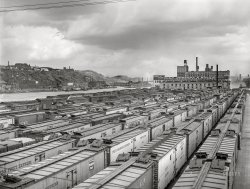
- Old Spanish Inn: 1937
- ... work in the early 1980s and returned to grad school in Pittsburgh we moved into a place a lot like this. She was not a happy camper. ... Posted by Dave - 08/30/2012 - 11:00am -
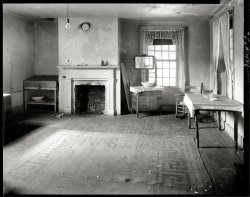
- Street Life: 1941
- June 1941. "Pittsburgh, Pennsylvania." Medium format acetate negative by John Vachon for ... a 10-year-old car.
Not Sad I grew up in several Pittsburgh neighborhoods similar to this one. They were communities, where ... in photos like this.
(The Gallery, John Vachon, Kids, Pittsburgh) ... Posted by Dave - 06/07/2020 - 4:05pm -
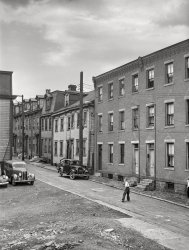
- PbSE: 1904
- Circa 1904. "Pittsburgh Stock Exchange, Fourth Avenue." 8x10 inch dry plate glass negative, ... there.
Where's the Rest of It? Perhaps some Pittsburgh historian can fill us in on why this grandiose but petite building ... Pope Roman Revival blockhouses.
(The Gallery, DPC, Pittsburgh) ... Posted by Dave - 12/02/2016 - 9:08pm -
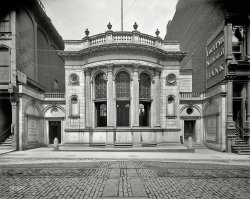
- Party Girl: 1942
- ... bedtime to take part in the fun. Allegheny-Ludlum Steel, Pittsburgh, Pennsylvania." View full size. Medium format negative by Alfred ... - Dave]
(The Gallery, Alfred Palmer, Kids, Pittsburgh, WW2) ... Posted by Dave - 09/11/2011 - 11:34am -
![Party Girl: 1942 August 1942. "George Woolslayer celebrated the visit of the soldier and sailor with a party at his home. Friends, relatives and fellow workers made up the list of guests. No ordinary party, this one will be remembered by the Woolslayers for years to come. Festivities started at 8 p.m. and lasted well into the next morning. Proudly seated on Sergeant French L. Vineyard's knee is Woolslayer's 8-year-old daughter, Georgia Ann, who stayed up long past her bedtime to take part in the fun. Allegheny-Ludlum Steel, Pittsburgh, Pennsylvania." View full size. Medium format negative by Alfred Palmer for the Office of War Information.
Strange lookSergeant French L. Vineyard has a strangely predatory look in his eyes, I wonder what he just said to little Georgia Ann that has her smiling in such a coquettish manner.
This photo is a little creepy, actually.
Take a second look.This picture reminds me of myself a lot. When I go to other friends' places, their kids just seem to flock to me. They climb on my lap and make themselves comfortable. I give them the look – What do you think your doing? The more I growl the more they seem to like me. These two are just getting along fine and that is all that is going on.
Sgt. F.L. VineyardFrench Vineyard is one of the most unGoogleable names I've ever come across.
A Model SoldierThere is a small photo of Sergeant Vineyard (who looks much nicer than in the one at the party) in the Washington Post of March 11, 1942.
His collar is undone and he has pulled his shirt open, like Superman. The caption reads, "Sergt. French L. Vineyard shows how American soldiers will wear two identification tags bearing the soldier's name, serial number, religion, blood type, date of tetanus immunization and the person to be notified in case of emergency. The new tags, of stainless and rustproof monel metal, replace the aluminum disk used by United States troops in World War I, which did not contain the valuable medical information."
The article does not say, but I understand that there were two "dog tags" so that if a soldier was killed, one could be taken for record keeping and one could be left with the body for identification when it was recovered later.
Sgt. VineyardVineyard's a bit of an unusual name. There is a listing for Sgt. Louis R. Vineyard of Oklahoma, of the 743rd Bomber Squadron, 455th Bomber Group (heavy) on the American Battle Monuments Commission web page for WWII burials overseas. He died on 20 December 1944 and is buried at the Sicily-Rome American Cemetery in Nettuno, Italy. Brother, perhaps?
[There are over 1,400 Vineyards in the Social Security Death Index. Including one Frank L. Vineyard, 1921-1998. - Dave]
(The Gallery, Alfred Palmer, Kids, Pittsburgh, WW2)](https://www.shorpy.com/files/images/8e11120u.thumbnail.jpg)
- Big John: 1942
- ... didn't give no lip to big John
November 1942. "Pittsburgh (vicinity). Montour No. 4 mine of the Pittsburgh Coal Company. Coal miner waiting to go underground." Medium-format ... Posted by Dave - 01/16/2017 - 10:26am -
